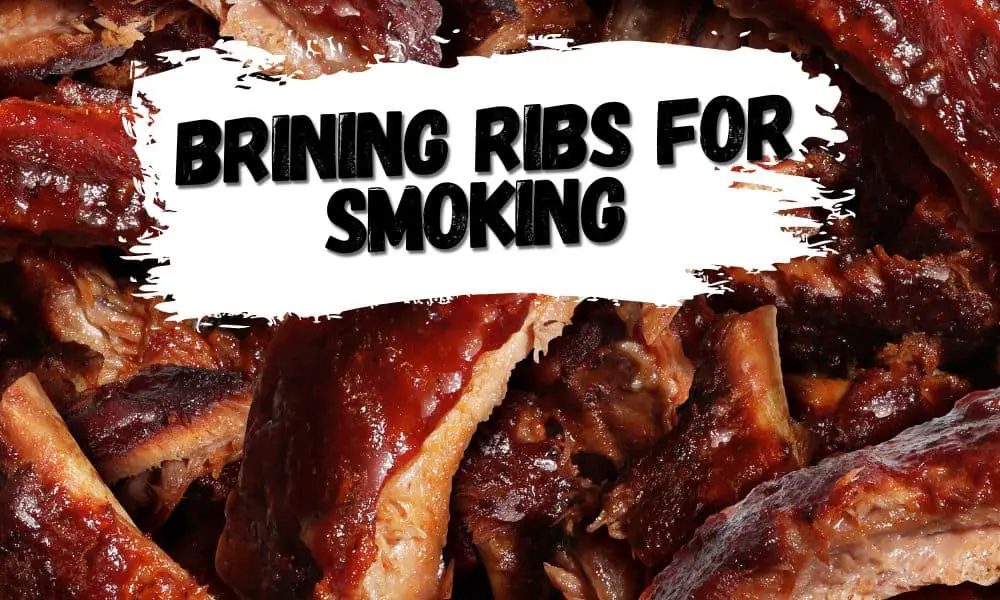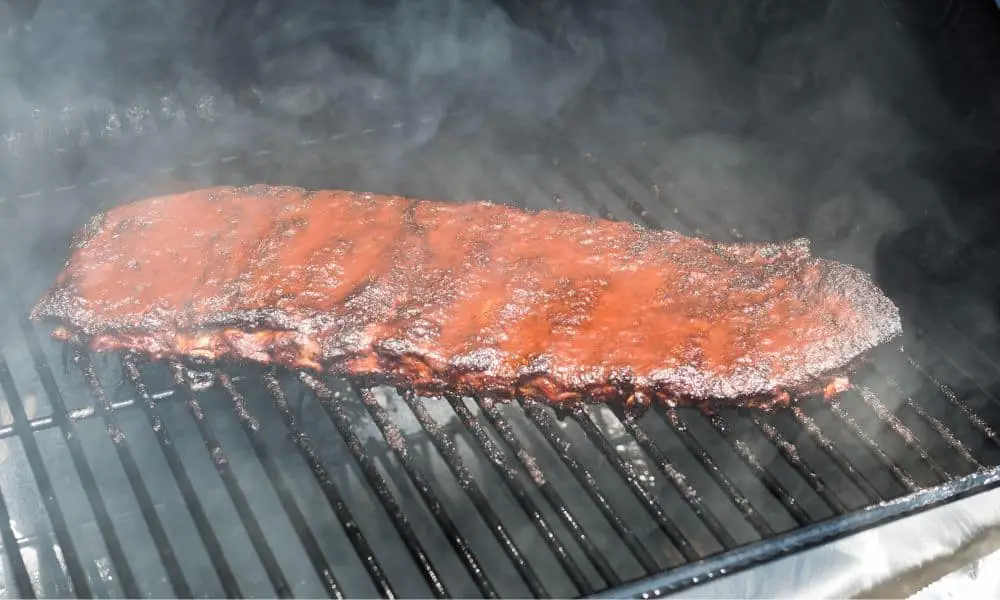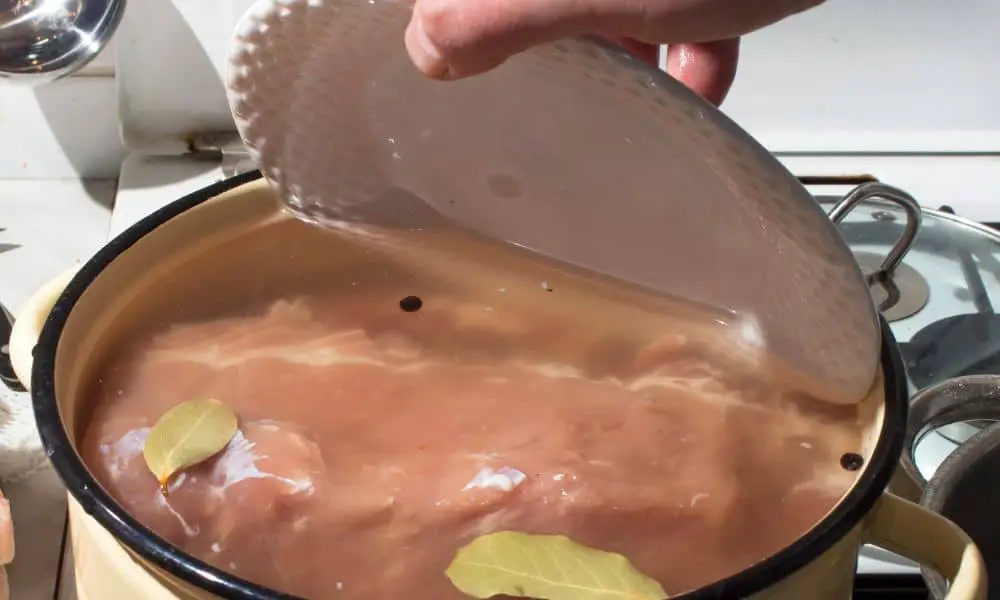Sure, brining has a reputation for enhancing tenderness and flavors for a variety of meats.
But, is all the effort really worth it when it comes to brining ribs before you’re smoking them?
Here we go through why some backyard barbecuers swear by brining their ribs for smoking, what the brining process actually does to ribs, whether you should brine ribs before smoking, and the best methods to do so.

There are really only two main reasons you would brine ribs for smoking. The first is to tenderize the meat and keep it moist, the second is to add flavor.
However, adding flavor comes second, as it’s not the true objective when it comes to brining meats.
Some barbecue enthusiasts swear by using brine on their pork ribs before smoking them, claiming it’s the key to the most tender ribs you’ve ever tasted.
However, other pitmasters and barbecue pros say it’s completely unnecessary, and may even take the tenderness too far, making the ribs harder to smoke properly.
Some even prefer to use a dry brine as opposed to a wet brine.
But here’s the beauty of barbecue: If you’re cooking then it’s your choice!
Although the general consensus is that brining ribs for smoking is simply not necessary, here’s everything you should know so you can choose for yourself.
What Does Brining Ribs Actually Do?
The key ingredient of any brine is salt. Salt is the predominant force behind the brining process.
The salt within the brine gets absorbed into the meat via osmosis. This helps the ribs take on additional moisture, and remain moist and tender throughout the smoking or cooking process.
This can be achieved by using a traditional wet brine, making a salty solution, and submerging your ribs in it for an extended period of time.
Or this can be achieved using a dry brine, a dry salty seasoning applied to your ribs well in advance of smoking time.
Both dry and wet brining methods help ribs retain their moisture over the cooking process, but wet brining allows the meat to absorb more moisture from the brine too!
What Type Of Ribs Can Be Brined?

Most types of pork ribs can typically be brined. But, each type of pork rib does have its differences which makes brining more or less effective or desired.
Pork spare ribs aren’t the meatiest of ribs. Although pork spare ribs can benefit from a wet brine, it should be noted that they need a lot less time in the brine than fattier cuts.
Pork baby back ribs tend to be a bit thicker, and can sit in a wet brine for a while longer, or can even benefit from a short dry brining too.
Country-style ribs can be brined too, so it’s really up to you!
On the other hand, it’s not as common to brine beef ribs. This is because beef ribs create their own moisture through the melting of the fat and collagen over the low and slow cooking process.
Beef ribs don’t need the excess moisture and it tends to ruin their texture more easily than when brining pork ribs. However, some still choose to brine beef ribs too.
Should You Brine Ribs Before Smoking Them?

Of course, it would be an easy answer if brining ribs only had upsides, then everyone would do it!
But, brining ribs does also have some downsides too.
So, the answer to whether you should brine ribs before smoking them comes down to what you value most in your smoked ribs, your smoking process, and whether you see brining as necessary to getting to the outcome you want.
Although brining ribs before smoking is certainly not necessary, some still choose to do it.
Here are the pros and cons to brining ribs for smoking, so you can decide if it’s worth it for you.
Benefits Of Brining Ribs
- The salt in the brine works to keep the meat moist and retain its juices, even over long smoking sessions.
- Brining can work to tenderize leaner cuts of meat, such as baby back or spare ribs.
- You can use the brining process to infuse further flavor into the ribs (with sugars & herbs).
- Dry brining can help create a crispier bark.
- If your pork ribs smell due to being cryovac’d, brining helps to remove this smell.
Disadvantages Of Brining Ribs
- If you plan to apply a delicious dry rub to your pork ribs, then things may get overly salty if you decide to brine your ribs too.
- It’s possible to over-brine your ribs, which causes an irreversible texture change in the meat.
- Brining is extra work and can be time-consuming.
- Brining is not a necessary process for smoking ribs. Pork ribs remain naturally tender over the low and slow smoking process.
- This is especially true if you are following the 2-2-1 or 3-2-1 method, smoking your ribs at 275°F.
Best Way To Brine Ribs For Smoking
If you want to tap into the ultimate power of brining, then you better be prepared to do it right.
If you make the brining solution haphazardly or brine your ribs too long you can be left with quite a disappointing end result.
So, here’s the best and most reliable method to follow for brining ribs before smoking them.
Step 1: Making The Brine

The most important step in the brining process is getting the brine right.
Some barbecue enthusiasts like to get a bit creative here and add juice, apple cider, vinegar, herbs, spices, or even beer to their brine for extra flavor.
But, the basics to get right is adding enough salt and a bit of sugar for good measure.
An easy and effective rib brine is:
- 10 cups of water
- ½ a cup of salt
- ½ a cup of sugar
- 3-4 bay leaves
- 2 cups of apple juice or apple cider
And mix thoroughly!
Step 2: Submerging Your Ribs
Before submerging your ribs in your glorious brining liquid, be sure the liquid is adequately chilled. You don’t want the temperature of the brine and meat warming up to unsafe temperatures!
Also, make sure you’ve got a big enough pot or container. Remember, when you add the ribs the water level will rise! Believe me, you don’t want this salty and sugary mixture going all over your kitchen!
Submerge your ribs in the brine and place your ribs in the fridge for between 2 – 8 hours, depending on how thick your ribs are and how much time you’ve got on your hands.
Step 3: Pat Dry
Don’t sleep on this last step.
Once you’re ready to smoke your ribs, it’s essential you pull them out of the brine and thoroughly pat them dry.
After your ribs are adequately dried you can then apply your binder and apply your favorite rub, as normal.
Just remember, the brining process will have already enhanced the salty flavor of the pork ribs, so don’t go overboard with any salty rubs.
Dry Brining Ribs Before Smoking
Dry brining has a similar effect, infusing extra salt into the meat to help it retain more moisture over the cook. But, it can also more easily dry out your ribs, as it doesn’t provide your ribs with any additional moisture as wet brining does.
A typical dry brine for ribs would be about ¼ teaspoons of salt per pound of meat.
Simply apply your dry brine to the whole surface of your ribs, wrap them in foil or plastic wrap, and place them back into the fridge.
Generally, pork ribs only need an hour or two of dry brining, but thicker cuts of ribs can go for up to 4 to 6 hours.
After the brining process, if you haven’t over-salted your ribs you shouldn’t need to remove any excess salt. But, you might want to adjust your rub knowing your ribs have already been salted.
Alternatively, instead of using plain salt as your dry brine, you can simply apply your rub as normal and let it sit for 2 hours before smoking them!
Final Thoughts
So although brining your ribs before smoking them is certainly unnecessary, if done right it can create something spectacular.
During the brining process, the salty solution infuses into the ribs itself, helping them take on more moisture and hold it throughout the cook. Not to mention you can use the brining period as an opportunity to build additional flavor!
But, if done incorrectly you can be left with some pretty salty and soggy-textured ribs too.
Any cut of pork ribs is fit for a brining. But it’s up to you whether you want to apply a wet brine, a dry brine, or no brine at all!

